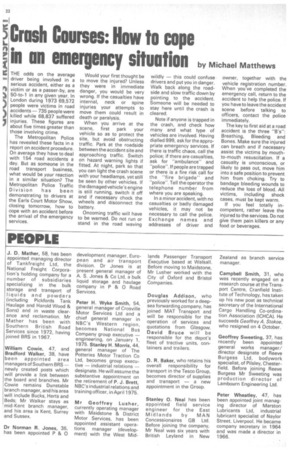in on emergency situation
Page 24

If you've noticed an error in this article please click here to report it so we can fix it.
THE odds on the average driver being involved in a serious accident, either as a victim or as a passer-by, are 50-to-1 in any given year. In London during 1973 69,572 people were victims in road accidents — 735 people were killed while 68,837 suffered injuries. These figures are about five times greater than those involving crime.
The Metropolitan Police has revealed these facts in a report on accident procedure. On average they have to deal with 154 road accidents a day. But as someone in the road transport business, what would be your reaction in a similar situation? The Metropolitan Police Traffic Division has been demonstrating to drivers at the Earls Court Motor Show, closing tomorrow, how to cope with an accident before the arrival of the emergency services. Would your first thought be to move the injured? Unless they were in immediate danger, you would be very wrong. If the casualties have internal, neck or spine injuries your attempts to move them could result in death or paralysis.
When you arrive at the scene, first park your vehicle so as to protect the site, but avoid obstructing traffic. Park at the roadside between the accident site and approaching traffic. Switch on hazard warning lights if fitted. At night, park so that you can light the crash scene with your headlamps, yet still be seen by other vehicles. If the damaged vehicle's engine is still running, switch it off and if necessary chock the wheels and disconnect the battery.
Oncoming traffic will have to be warned. Do not run or stand in the road waving wildly — this could confuse drivers and put you in danger. Walk back along the roadside and slow traffic down by pointing to the accident. Someone will be needed to stay here until the crash is cleared.
Note if anyone is trapped in the crash, and check how many and what type of vehicles are involved. Having dialled 999, ask for the appropriate emergency services. If there is traffic chaos, call the police; if there are casualties, ask for "ambulance" and "police". If people are trapped or there is a fire risk call for the "fire brigade" and "police". Tell the operator the telephone number from where you are speaking.
In a minor accident, with no casualties or badly damaged vehicles, it may not be necessary to call the police. Exchange names and addresses of driver and owner, together with the vehicle registration number, When you ve completed the emergency call, return to the accident to help the police. If you have to leave the accident scene before talking to officers, contact the police immediately.
The key to first aid at a road accident is the three "B's": Breathing, Bleeding and Bones. Make sure the injured can breath and if necessary assist the victims by mouthto-mouth resuscitation. If a casualty is unconscious, or likely to pass out, move him into a safe position to prevent him from choking. Try to bandage bleeding wounds to reduce the loss of blood. All victims, including shock cases, must be kept warm.
If you feel totally incompetent, rather leave the injured to the services. Do not give them pain killers or any food or beverages.












































































































































